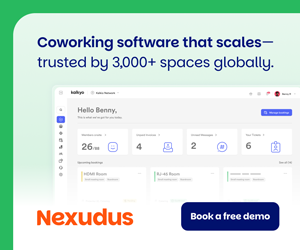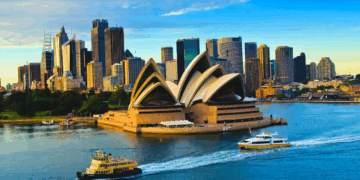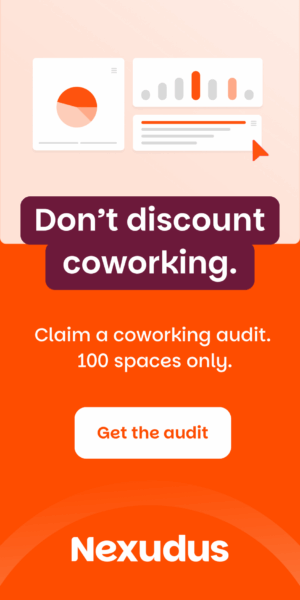- GoodWork in Dallas, TX is a coworking space that’s seeking LEED and WELL certification
- GoodWork converted an old diamond vault into a shared workspace
- Co-Founder Amy King discusses how to GoodWork has nurtured a truly diverse community and the challenges associated with rehabbing an abandoned building
GoodWork is raising the bar on coworking in Dallas, Texas. Led by co-founders Amy King and Steve Kinder, the GoodWork team is going for both LEED and WELL certification. With a strong focus on community, GoodWork aims to be good for its members and good for the planet.
Allwork.space chatted with King about the decision to build green, how they’ve created one of the most diverse coworking spaces in Dallas (and beyond), and converting an old diamond vault into a shared workspace. Here are the highlights of our conversation.
Allwork.Space: Let’s start with some background on GoodWork. How have you and Steve Kinder collaborated to bring GoodWork to life?
Amy King: Steve identified the promise of this building and had a vision for a mixed use future-focused offering. I brought the vision for the coworking space and our greater purpose. I also handle the culture aspect and am actually running the space. Steve brings the perspective on designing flexible workspace. He’s an industrial designer and serial entrepreneur, so he brings the entrepreneurial experience.
His company was a client of my previous company, Nested Strategies. They were producing a lot of content around the future of work and I had identified coworking as a niche market for his products. I dragged him to GCUC Austin, and GoodWork sparked from there. He was getting into building and development and I proposed the idea of opening a coworking business.
Steve provided the seed funding to get us going, and the mentorship. His job was to get the building up and running. I was very involved because of my green building background and the whole design thinking process.
Allwork.Space: Tell me more about your background. How did your previous experience lead you to coworking?
I started my career working for big ad agencies in New York. I’ve always had the storytelling piece, and a passion for sustainability. I got promoted to TV producer because I was willing to do the PSAs.
I moved over to the U.S. Green Building Council (USGBC) and was head of community, so I oversaw their 80 nonprofit chapters across the U.S. That involved everything from community development, to relationship management, to marketing and communications. I learned a lot about what to do, and what not to do, around organizational culture and how that intersects with having a green building. You can have a beautiful LEED Platinum building but still have organizational and cultural challenges in the space.
When I learned about coworking as a business concept, it was a huge lightbulb moment for me. I realized I can do all the things I love: help people grow their businesses, incubate triple bottom line concepts into their businesses, and share the new, better way to work around taking care of themselves and working in a healthy space. Coworking pulls all of that together.
Allwork.Space: Sounds like the perfect alignment for you. Was Steve on-board with the green building from the start?
He knew I brought that to the table because I had been helping his company navigate how to be a USGBC member and how to vet their materials and products to be LEED compliant. He knew I was super-passionate about green building and it was all new to him.
He’s enough of a visionary to see where the world is going—to understand that green building is important to the next generation and that it can be a differentiator. So, while he didn’t have the technical knowledge, he bought into partnering with me and brought Gary Olp, FAIA and LEED Fellow, from GGO Architects, who’s also my fiance, on-board. It was a passion project for all of us.
We’re creating something that’s a real education piece for the city—a living, breathing place. We have a lot of different types of people in and out of the space on a daily basis who can learn about what it means to be working in a green, LEED building, and, hopefully, a WELL certified building.
Allwork.Space: Tell me more about that education piece. You took an existing building and rehabbed it, so you’re using it as a model of what can be done when restoring or redoing old buildings?
Dallas, in the past, has been known to be a city that just knocks down its historic buildings, but they’re trying to change that. The most sustainable thing to do is to not build a new building, but to take an existing building and do a gut rehab.
It’s a bigger commitment and it’s not as black and white as having a plan and building. You encounter a lot of surprises as you pull apart an old building. This building has great bones. It’s a 1950s building that had been sitting vacant for years but, believe it or not, the entire sprinkler system, minus one pipe, was still working.
Allwork.Space: What was the building originally?
As it turns out, the building has a great story and is in a really cool area we’re coining the Produce District, with the double-entendre of producing things and also there are also produce markets all around. This building was a wholesale diamond and watch family-owned business. There’s an old vault in the showroom in the front of the building that we discovered, after a lot of research into what this building had been, was a diamond vault.
Right now, we’re taking one of our smaller phone booth-sized rooms and making it into a content studio. Long term, we want to find some corporate or entertainment sponsors to help us fit the vault out as a sound studio. It’s a cool room—it’s really long and just a cool space everybody is fascinated by.
The building definitely has an industrial feel, with concrete exposed on the ceiling. Right now it’s fairly eclectic with furniture and layout, but there is a bigger vision behind how we mapped out the space for zones, including a focus zone and a collaborative zone. We’re trying to be more intentional about having areas where people really feel like they can get focused work done.
As we all know, one of the biggest complaints with the open plan model is that it can be hard to focus. LEED and WELL certification build in things that help people with their productivity, like exposure to daylight and ergonomic chairs and standing desks. We want it to be a teaching tool to encourage people to demand more from their workspace. Our workspaces should be healthy, dynamic, living, breathing spaces instead of static, dark boxes with terrible air.
Even with the ventilation alone, we have a really high-end HVAC system. We pull a tremendous amount of fresh air into the building and have the highest level of filtration. You don’t get that 3 p.m. headache that a lot of people get.
Allwork.Space: It’s a big space to tackle, right?
The whole building is 58,000 square feet over two floors. Our footprint is the whole first floor. We’re the anchor tenant and social engine for the building. My business partner wears both hats—he’s the building owner and cofounder of GoodWork.
My narrative in the beginning of this project and business was that, because of the way commercial real estate is going, a lot of the smaller, independent coworking spaces are getting their rents jacked up by their landlord and a better way to go is to own your building. Now that I’ve been immersed in the process and understand the real numbers behind it, it’s really hard without some serious backing to have the prospect of actually owning your building.
But owning the building takes out the fear factor of wondering if we’ll be able to afford being here in three years. We’re creating a neighborhood. We’re on the fringe of an up and coming neighborhood and there’s not really any residential around us right now, but that’s about to change. We were the first. We urban pioneered our block and now all these developers are coming after us.
Allwork.Space: Who is the GoodWork community? Do you attract people who prioritize working in a green building that promotes wellness?
I founded Nested Strategies on the premise that sustainability has a branding problem. I went in, very intentionally, knowing that we’re not going to hang our shingle out front saying this is a green coworking space. That’s partially because we’re in Texas and you have to be careful about your language. We’ve also been having conversations about this in the political climate, as well, that the only way to effect real change in this polarized world is if you attract people to a conversation.
We talk about having a focus on wellness and productivity and, on our website, we promote that we’re pursuing LEED and WELL certification, but we set out to intentionally be a super-inclusive space. That’s one of the biggest goals. You look at biomimicry, and ecosystems, and thriving ecosystems are based on diversity. I had no interest in being an all-tech space, or an all-anything space. I wanted us to have a cross-section of different viewpoints, and gender diversity, ethnic diversity, professional diversity. We’ve been very intentional in cultivating those relationships.
They always say pick your top 10 people you couldn’t live without in your core membership, and build from there. We’ve done that. We were also really intentional about having people of color in our marketing. Our membership of about 130 members, looks like nothing else in this town, or basically anywhere I’ve seen. I want to do some kind of demographic survey but, If I had to place a bet, I’d say we’re 60 percent white and 40 percent people of color. I’m looking out in the space right now and I don’t even see any white people.
Allwork.Space: That is extraordinary in coworking. You’re doing something very few spaces have figured out how to do by being home to a truly diverse community.
We partnered with a fledgling incubator and accelerator called Impact House run by a guy named BJ VANN, who has become a really good friend. They were also doing a space, but BJ decided he didn’t want to run a space, he just wanted to focus on programmatic stuff. We opened a month early for their core members of about 10 people.
BJ is committed to getting more opportunities for entrepreneurs from South Dallas and creating a more inclusive entrepreneurial community. We’re partnering on programming—I’m going to be a mentor in his accelerator program—and we’re jointly creating an ambassador program to get more people talking about what we’re doing and have deeper connectivity in the community to what we’re doing so even non-entrepreneurs and students can participate in programs and champion what we’re doing.
Allwork.Space: What has been the biggest challenge around creating such a large, green coworking space?
Overall, putting systems and processes in-place so we can replicate it, and doing everything the right way just takes longer, and sourcing all the eco-friendly products costs more money. We’re prototyping a desk because we couldn’t find anything we could afford, that we like, that we could do for WELL certification. We literally went to the lumber yard yesterday and are finishing the desks with linseed oil and are building big community tables. It’s all stuff other spaces do, but we’re having to also factor in all the WELL guidelines.
Allwork.Space: What’s next for GoodWork? What are you working on now?
We partnered with Sunfinity Solar and Downwinders at Risk Sue Pope Fund and just received our portion of the energy rebate for our solar array we have on the roof—we have 454 solar panels. I’m fine-tuning my budget then we’ll start sourcing the workstation chair—I call them the unicorn chairs—that have every ergonomic feature under the sun and are nontoxic. We’re about to implement a bunch of stuff in order to pursue our WELL certification.
We filled all our offices first, so we’re going to be doing a big push this summer for open coworking, and we’re ramping up our programming and fitness offerings. Right now, we have kickboxing and yoga. That’s part of WELL certification, having a fitness program and fitness incentive programs.
Allwork.Space: What’s your big picture vision for GoodWork?
I want to make this replicable while still preserving the local community feel. I want to prove that you don’t have to set aside sustainability stuff to scale a business—that you can do it the right way.
Certified B Corporations have a hard time going to a public offering because shareholders want short-term returns. I want to help shift the whole business mentality and culture and model. Doing things the better way, not the easier way, is a challenge. I’m really proud that we’ve bootstrapped it so far, and we might just grow organically.
Allwork.Space: Hanks, Amy. Anything you’d like to add?
It’s all women who have been doing the fabrication. I have a lot of badass babes around. We’re co-owned by a very smart, progressive man, but we’re women-run. Another surprising factor is that we’re doing something like this in Texas. People are surprised to see what we’re doing. I think it’s important to do that here because you’re not preaching to the converted, although Dallas has become more progressive as it grows.


 Dr. Gleb Tsipursky – The Office Whisperer
Dr. Gleb Tsipursky – The Office Whisperer Nirit Cohen – WorkFutures
Nirit Cohen – WorkFutures Angela Howard – Culture Expert
Angela Howard – Culture Expert Drew Jones – Design & Innovation
Drew Jones – Design & Innovation Jonathan Price – CRE & Flex Expert
Jonathan Price – CRE & Flex Expert












